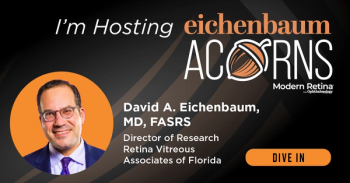
Novel DME treatment derives from multimodal activity
ALG-1001 is an integrin receptor inhibitor that acts to stabilize the retina’s response to diabetes-related hypoxic and oxidative stress, mitigating production of a host of molecules involved in the development of diabetic macular edema.
Anti-integrin therapy with ALG-1001 (Luminate, Allegro Ophthalmics) represents a novel approach to treatment of diabetic macular edema (DME) that addresses the multifactorial pathophysiology of the disease by targeting an early point in its pathogenic pathway.
As an inhibitor of three integrin receptors, a5b1, avb5, and aMb2, ALG-1001 interferes with cell cycle signaling that is induced by diabetes-related retinal oxidative stress and leads to the production of cytokines, growth factors, and other molecules that mediate neovascularization, vascular leakage, inflammation, and damage to the neuroretina.
This broad range of effects explains why analyses of results from phase II clinical trials showed that whether given as monotherapy or sequentially after a single intravitreal anti-VEGF injection, ALG-1001 demonstrated particular benefit for improving vision and anatomic outcomes in patients who were suboptimal responders to previous anti-VEGF therapy.
“Integrin-targeted therapy has an established role in oncology and autoimmune disease, but ALG-1001 is a first-in-class molecule in ophthalmology,” said Vicken Karageozian, MD, president and chief medical officer, Allegro Ophthalmics, San Juan Capistrano, CA.
“Unlike anti-VEGF agents that address a downstream actor in DME, ALG-1001 works higher up in the pathogenic pathway at the source of the problem,” he said. “By stabilizing the retina’s response to the hypoxic and oxidative stress that occurs with diabetes, it essentially works to turn off the faucet that is producing all of the mediators of diabetic eye disease.”
ALG-1001 is a synthetic RGD class peptide that acts to downregulate the PI3K pathway by binding to and inhibiting the a5b1, avb5, and aMb2 integrin receptors. Both a5b1 and avb5 are intimately involved in the regulation of neovascular remodeling, neovascular construction, and vascular leakage, whereas aMb2 modulates inflammatory pathways involving both leukocyte adhesion and migration and complement 3.
“Stimulation of the PI3K pathway in the retina signals cells to respond to diabetes-induced stress,” he said. “Anti-integrin therapy with ALG-1001 stabilizes this cell signaling pathway to turn off inflammation, stop production of proangiogenic and other deleterious growth factors, and stabilize the neuroretina.”
Clinical data
Stage 1 of the phase II program investigating ALG-1001 as treatment for DME enrolled 136 patients and compared it as monotherapy against bevacizumab (Avastin, Genentech). Results reported in 2016 showed that the novel investigational agent had excellent safety and was equivalent to bevacizumab in analyses of primary and secondary endpoints looking at improvements in BCVA and central retinal thickness.
The study also identified 1 mg as the best dose of ALG-1001 and showed its activity was durable for 12 weeks. Used in monotherapy without clearing existing VEGF burden on the eye, time to onset of benefit with ALG-1001 without anti-VEGF pre-treatment was delayed by 3 months.
The stage 2 phase II study was designed to compare treatment with the combination of bevacizumab and ALG-1001 0.5 or 1.0 mg given monthly for 3 cycles, a sequential approach beginning with a single injection of bevacizumab followed by three monthly doses of ALG-1001 0.5 mg or 1.0 mg, or five monthly doses of bevacizumab. Follow-up was continued through week 20, 12 weeks after patients would have received their last ALG-1001 dose.
“Recognizing there is a high level of VEGF in the vitreous of eyes with established DME, we hypothesized that sequential therapy beginning with an anti-VEGF agent followed by ALG-1001 would be beneficial by providing a 1-2 punch,” he said. “The anti-VEGF agent would first clear out VEGF that was already present in the eye and then treatment with ALG-1001 would stop further production of VEGF along with other angiogenic, inflammatory, and apoptotic factors involved in DME pathogenesis.”
Results verified the hypothesis and showed that the anatomic and functional improvements achieved with the sequential approach were non-inferior to those seen in the bevacizumab monotherapy arm at all follow-up visits conducted at weeks 4, 8, 12, 16, and 20. Compared with outcomes of ALG-1001 monotherapy recorded in the stage 1 trial, BCVA gains achieved with the sequential approach using ALG-1001 1.0 mg were about 40% improved.
The combination regimen in which patients were given an intravitreal injection of bevacizumab and then ALG-1001 after 1 hour was associated with poorer results, which is explained by metabolic interference between the two compounds, Dr. Karageozian said.
“We showed mechanistically that the initial anti-VEGF injection while clearing the fluid and blood from the retina actually puts more oxidative stress on the retina,” he said. “Working in opposite metabolic directions using the two drugs simultaneously seems to limit the efficacy of ALG-1001 when it was given almost immediately.”
Additional analyses of data collected in the stage 2 phase II study is ongoing, but planning for a phase III study of ALG-1001 for the treatment of DME is under way. Dr. Karageozian said he hopes to meet with the FDA for guidance early in 2018 and that the study may be launched in the middle of the year.
Although the protocol is yet to be finalized, based on the findings of the subgroup analyses from the second phase II study, Allegro is planning to enroll patients who are “plateaued responders or non-responders” to repeated anti-VEGF injections. Such patients represent about 50% of the population treated with anti-VEGF therapy for DME.
“The registry studies that led to approval of aflibercept (Eylea, Regeneron) and ranibizumab (Lucentis, Genentech) enrolled treatment-naïve patients because the virgin retina responds best to anti-VEGF," Dr. Karageozian said. “However, now that anti-VEGF agents have been used for a number of years to treat DME, there is a large pool of patients who are not treatment-naïve and who have not achieved an adequate response to anti-VEGF therapy. With its multimodal mechanism of action, ALG-1001 is well-match to treat these patients.”
Newsletter
Keep your retina practice on the forefront—subscribe for expert analysis and emerging trends in retinal disease management.












































